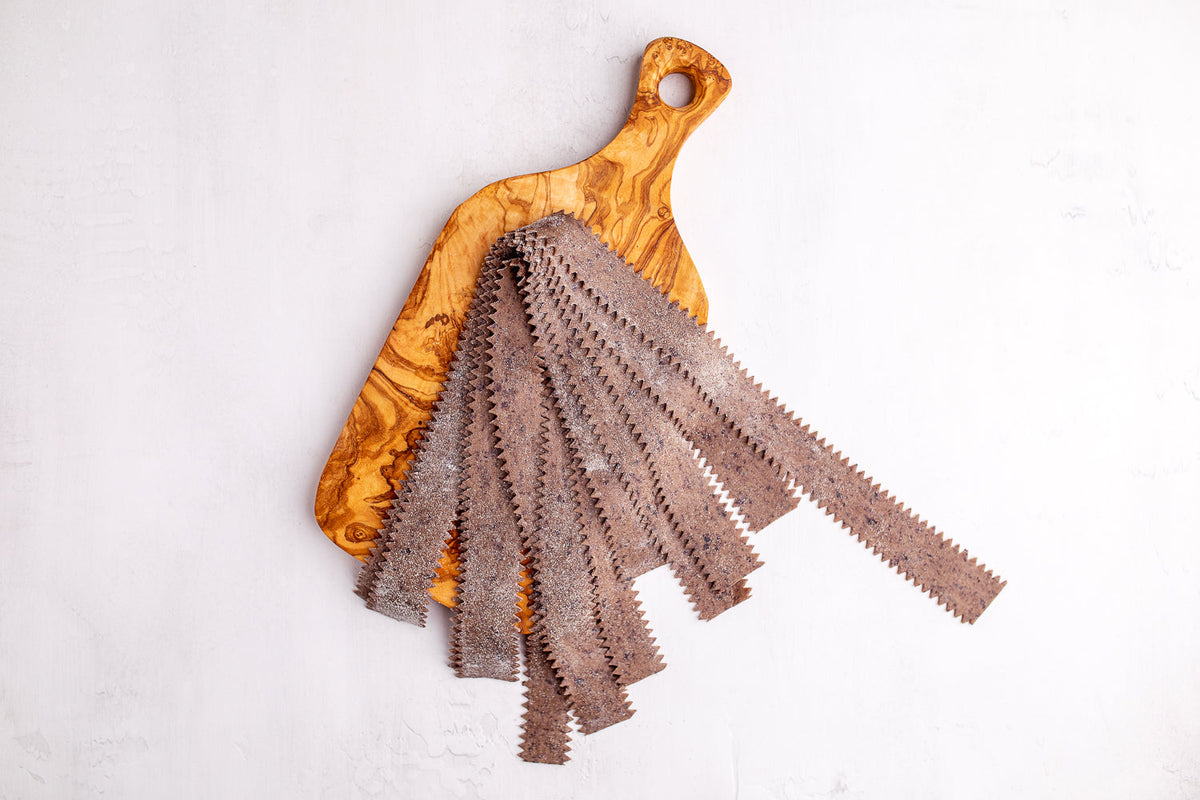
Olive Malfaldine
|
|
Time to read 3 min
|
|
Time to read 3 min
While I love all pasta shapes, I often find myself gravitating towards thick, fat noodles or pasta shapes with lots of texture. The most common in our pantry include bucatini, giant rigatoni, and a rotating assortment of curled edge pasta, from casarecce to fat fusilli. This array usually sits next to three or four jars of green and purple olives, stocked up in case of an emergency need for a fancy snack or impromptu aperitivo. In fact, it’s this shelf in my pantry that is one of my favorites: its contents often come in handy when there is nothing in our fridge. I can rest easy knowing that so long as there is pasta a few jars of something or another to go with it, we’ll eat good that night.
One pasta shape that isn’t so easy to find on supermarket shelves, however, is mafaldine. It’s a wide and long ribbon-like pasta with fancy curled edges. You’ll sometimes also see it called reginette, but I personally prefer the name mafaldine, which comes from the Italian Princess Mafalda of Savoy. She is one of the many Italian royal female figures to have a pasta or a dish named in her honor.
I’ll spare you the tragic story of Princess Mafalda and instead get right to this recipe: homemade olive mafaldine. Typically mafaldine are made from durum wheat semolina and water, and extruded through a bronze die, but here I’m breaking tradition and making them fresh, colored a blackish-purple with olive puree.
Coloring pasta is fun, but it usually doesn’t result in a whole lot of flavor within the pasta itself. But because olives have such a pronounced, briny flavor, you’ll notice that the olivey flavor shines through in this pasta. For this reason, you’ll want to salt your pasta water a little less than usual.
This pasta is great with a simple tomato sauce, topped with a few extra olives and fresh basil or oregano. Or you could marry together all the briny flavors and go for a mixed seafood sauce.

60 Minutes, plus resting
5 minutes
4
1 (10-ounce) jar of kalamata olives
100 grams olive puree
360 grams 00 flour
90 grams fresh eggs (about 2 whole eggs)
Drain the kalamata olives, reserving the brine in a small bowl.
Using a food processor or immersion blender, puree the olives, adding 1-2 tablespoons of brine to help smooth out the puree.
Dump the flour out onto a clean work surface. Make a well in the center and add in the olive puree and eggs.
Use a fork to beat together the olive puree and eggs, then slowly incorporate the flour until you have a shaggy dough. Knead together by hand for 15 minutes until a smooth, tacky dough ball forms. When kneading, if the dough is too dry, add a little spritz of water using a fine mist spray bottle. If the dough is too wet, add a sprinkling of flour.
Cover the dough in plastic wrap. Let it rest at least 30 minutes and up to 2 hours, covered, at room temperature.
Using a hand-cranked pasta machine, roll out the dough, a quarter at a time, into thin sheets. Trim the ends using a pastry wheel so that you have a rectangular shape. Next, use a fluted pasta wheel to cut the sheet into four long ribbons, about ¾-inch wide.
Set the mafaldine ribbons aside on a parchment-lined baking sheet. Continue in this way until all the dough has been used.
Cook the pasta in a pot of boiling salted water for about 3-5 minutes. Taste for doneness. Serve with your sauce of choice.
You could pair this olive pasta with a simple tomato sauce or a mixed seafood sauce. It’s also excellent with a little bit of garlic, tomatoes, and olives sautéed in olive oil and topped with basil or oregano.
See our How to Store Fresh Pasta Guide for storing tips.